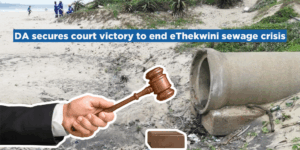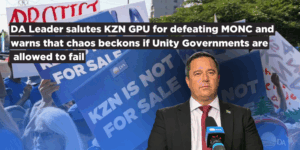Upgrading and maintaining its infrastructure is one of the ways in which Knysna Municipality fights against pollution of one of the most important and popular natural attractions of the area – the Knysna estuary.
“A crucial factor is ensuring that our wastewater treatment works functions well,” said member of the Mayoral Committee for Infrastructure Peter Bester. “We have recently spent R12,5 million on upgrading various mechanical and electrical works at the plant. This minimises the impact our wastewater has when it is discharged and has increased the plant capacity. The quality of our effluent far exceeds the standards prescribed by the Department of Water Affairs.”
The Knysna wastewater treatment works has passed 87.5% of bacteriological tests since the start of the financial year, only failing these tests while waiting on commissioned parts or works. “We have strict maintenance programmes in place to ensure the effective running of the plant,” confirmed Bester. “There are additional measures in place to ensure that these programmes are adhered to in practice, which means that our plant is stays well maintained.”
The municipality has also been upgrading and, in many cases, replacing infrastructure that forms part of the greater wastewater system. This includes upgrades to the Hornlee sewer line; upgrading the CBD sewer reticulation system; constructing a new pump station; and installing sump systems with bar screens to effectively remove foreign objects from entering the sewer system.
“The Garden Route District Municipality collects water samples from specific areas of the estuary on a regular basis,” Bester continued. “These samples are tested for quality and compliance by an independent laboratory. The results are routinely uploaded to our website as a matter of public interest and in the spirit of transparency.”
“As with the management of any body of water, we do face certain problems caused by factors outside of our control,” said Bester. “Vandalism of our infrastructure is a major issue. This includes the wilful blocking of drains, pipes and culverts. Socio-economic circumstances also create situations where untreated waste flows into stormwater systems from informal settlements. We are, however, part of an active community that continuously works to the improvement of our environment and, particularly, our estuary.”
The Estuary Pollution Forum consists of representatives from Knysna Municipality, SANParks, the Garden Route District Municipality, the Breede-Gouritz Catchment Management Agency and other stakeholders. “This forum meets on a monthly basis to monitor the state of the estuary,” Bester explained. “And the municipality has developed initiatives that address specific concerns raised during these meetings.”
These initiatives see Knysna Municipality taking continuous, direct action in preserving the integrity of the estuary.
- Specific pump stations are inspected on a daily basis to identify and remove any blockages.
- All pump stations are maintained and cleaned as a matter of routine.
- Stormwater channels and culverts are cleaned regularly
- Hotspot areas are subject to ongoing inspections and investigations.
- Both bulk- and reticulation sewer networks have been, or are being, upgraded to improve the capacity of these systems.
- Business premises are routinely inspected to ensure compliance with wastewater and waste disposal by-laws.
A project aimed at identifying specific sources of pollution in stormwater culverts is planned for the new financial year. “It might be a cliché, but prevention is better than cure,” said Bester. “A structured testing programme will allow us to pinpoint the origin of problems in the stormwater system and, once identified, suitable initiatives can be designed and implemented to solve specific situations.”
“We recognise that the Bongani River is probably the single biggest source of pollution entering the estuary,” he said. “A rehabilitation plan has been drafted by freshwater ecologists and recommends the construction of hard engineering structures to assist in mitigating the situation. We have obtained a water use license and are appointing an engineer to work on the specifications of the relevant tender documents.”
A crucial inclusion of the Bongani rehabilitation plan is an education and awareness campaign. “Residents must be informed of the negative impact they have on our estuary – and the pollution they cause – by disposing of inappropriate objects in the sewer system. We must create and foster a culture of ownership and shared responsibility for the wellbeing of our natural resources.”
“We need our residents and local businesses to work with us to protect not only our estuary, but all of our natural environment,” Bester concluded. “Our area’s natural beauty has always been a major drawcard for domestic and international travellers, and global travel restrictions are gradually being eased. As our local economy is heavily dependent on tourism, we must ensure that the beauty and environmental health of Knysna – and our lagoon – keeps welcoming new and returning visitors. Aside from that, we all deserve to live in a clean, beautiful, inclusive, innovative and inspired Knysna.”
Please report illegal dumping by sending a WhatsApp to 060 998 7073 or calling 044 302 631. Estuary water quality test results are regularly updated to our website at https://www.knysna.gov.za/live-here/environment/lagoon-update/.




